Less waste, more control: How Trimble is rethinking prefab efficiency
by Harsh Pareek, Regional Sales Director, India and SAARC, Trimble Solutions
Prefab construction promises speed and efficiency, but outdated workflows often lead to costly waste and delays. Trimble is changing that by digitising every step of the prefab process—from design to fabrication—bringing precision, control, and sustainability to the factory floor. The result: less waste, smarter use of resources, and more reliable, future-ready construction
In the prefab world, waste doesn’t always look like a dumpster overflowing with scraps. Sometimes it’s just a miscut steel beam or a wrongly sized panel that quietly sits in a corner, unused, or an entire day lost because someone kept reading the wrong version of a drawing.
Off-site construction was supposed to solve these problems, but the truth is that many factories are still running on outdated workflows and systems. Automation without intelligence leads to expensive inefficiencies. And for an industry already under pressure to deliver faster, cheaper, and greener, that’s no longer good enough.
Trimble isn’t just digitising prefab it’s giving manufacturers full visibility and control over their entire factory process. And the result of this is dramatic reductions in material waste, smarter use of resources, and a level of precision that turns prefab into true industrialised construction.
The silent cost of waste
Every mistake on a building floor has a ripple effect whether it’s due to a wrong measurement or a late design change, the impact is felt in extra material costs, rework, and scheduling headaches. These errors often come to light too late when the piece has already been made or installed. Trimble’s actual strength lies in preventing these missteps before they happen. It’s connected systems sync every stage of prefab from design, detailing, production planning, and fabrication into one continuous digital workflow. This allows teams to detect clashes early, adapt to changes faster, and build exactly what’s needed, the first time around.
Central to this efficiency is Trimble’s model-based approach. Tools like Tekla Structures ensure that the digital model isn’t just for visualising but it also becomes the actual source of truth for manufacturing. Every element in the model is constructible, with the exact specifications needed to guide fabrication. This direct link between model and machine means there’s no room for miscommunication. CNC equipment receives its instructions from the same model the design team worked on ensuring precise cuts, correct placements, and reduced reliance on printed drawings or manual input. Which in turn means less material waste from misfabrication.
Inventory and production in sync.
A big source of waste in prefab often comes from poor material tracking either over-ordering or underutilising what’s already available. Trimble helps tie inventory data directly to production planning. If a design change affects material needs, procurement and shop-floor schedules can adapt in near real-time. This reduces the need for buffers, avoids unnecessary stockpiles, and enables better batching and nesting of materials. The benefit isn’t just lower costs it also means fewer offcuts, less scrap and a cleaner more predictable workflow.
Learning from the line
Trimble’s factory solutions also focus on continuous improvement. By monitoring production outcomes and feeding that data back into planning and design, manufacturers can fine-tune their processes over time. Are certain types of connections frequently requiring rework? Are there recurring delays on a particular assembly line? This feedback loop helps identify patterns and act on them optimising layouts, improving shop instructions, and eliminating sources of material loss that might otherwise go unnoticed. It’s not about working harder. It’s about working smarter, with better insight.
With rising material costs and growing pressure to build greener, waste reduction isn’t just a nice-to-have habit it’s a strategic advantage. And Trimble enables prefab shops to reduce environmental impact without compromising on productivity or quality. By limiting overproduction, improving fabrication accuracy and eliminating the need for rework, the entire process becomes leaner and more sustainable. And this shift isn’t just good for the planet it’s good for business too. Because less waste also means more profit.
India’s Prefab moment
India is at a delicate moment in its infrastructure journey, with an increasing push toward modular and off-site construction for housing, commercial and industrial projects. But scale without precision leads to chaos. That’s why tech-enabled control systems are becoming a must. Trimble is working with Indian prefab players to embed smarter workflows into the factory floor making sure production aligns with design, reducing friction across teams, and keeping material use efficient and accountable. Whether it’s a large-scale precast plant or a smaller steel fabricator, these digital upgrades help ensure that no resource is wasted and no mistake is repeated.
In prefab, small improvements add up like a few fewer errors per batch, a better use of steel coils, one less change order going unnoticed. These aren’t headline-grabbing wins, but they are exactly what separates chaotic factories from efficient, future-ready operations. Trimble’s approach puts the tools and the data back in the hands of those who need it most. It helps factories stay lean, focused, and agile, without compromising on quality. Because when you can control your process, you can control your waste. And in prefab, that’s the smartest build of all.
Tags
Related Posts
















